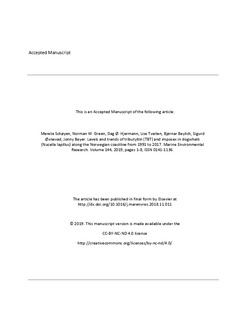| dc.contributor.author | Schøyen, Merete | |
| dc.contributor.author | Green, Norman W | |
| dc.contributor.author | Hjermann, Dag Ø | |
| dc.contributor.author | Tveiten, Lise Ann | |
| dc.contributor.author | Beylich, Bjørnar | |
| dc.contributor.author | Øxnevad, Sigurd | |
| dc.contributor.author | Beyer, Jonny | |
| dc.date.accessioned | 2019-10-14T15:21:03Z | |
| dc.date.available | 2019-10-14T15:21:03Z | |
| dc.date.created | 2019-03-12T16:35:19Z | |
| dc.date.issued | 2019 | |
| dc.identifier.citation | Marine Environmental Research. 2019, 144, 1-8. | nb_NO |
| dc.identifier.issn | 0141-1136 | |
| dc.identifier.uri | http://hdl.handle.net/11250/2622076 | |
| dc.description | Embargo until 16 Nov 2020 | nb_NO |
| dc.description.abstract | The banning of organotin biocides, such as tributyltin (TBT), from use in marine antifouling paints is now leading to reproductive health recovery in marine gastropod populations all over the world. TBT induces socalled imposex (superimposition of male sexual characters onto females) in certain marine gastropods, such as the common dogwhelk Nucella lapillus. In this publication, the results of the Norwegian TBT and imposex monitoring in N. lapillus from the period 1991-2017 are presented. Significantly higher levels of TBT and imposex were measured in coastal areas close to shipping lanes along most of the coast prior to 2008 than afterwards. Levels started declining after restrictions were imposed on the use of TBT in all antifouling paint applications, with a total ban in 2008. In 2017, no sign of imposex was found in N. lapillus in any of the monitoring stations along the Norwegian coastline. Based on monitoring data shown herein, the importance of long-term biomonitoring and international chemical regulations, as well as the TBT and imposex story in general, are discussed. | nb_NO |
| dc.language.iso | eng | nb_NO |
| dc.publisher | Elsevier | nb_NO |
| dc.rights | Attribution-NonCommercial-NoDerivatives 4.0 Internasjonal | * |
| dc.rights.uri | http://creativecommons.org/licenses/by-nc-nd/4.0/deed.no | * |
| dc.subject | Imposex | nb_NO |
| dc.subject | Tributyltinn | nb_NO |
| dc.subject | Tributyltin | nb_NO |
| dc.subject | Biologiske effekter | nb_NO |
| dc.subject | Biological effects | nb_NO |
| dc.subject | Norge | nb_NO |
| dc.subject | Norway | nb_NO |
| dc.title | Levels and trends of tributyltin (TBT) and imposex in dogwhelk (Nucella lapillus) along the Norwegian coastline from 1991 to 2017 | nb_NO |
| dc.type | Journal article | nb_NO |
| dc.type | Peer reviewed | nb_NO |
| dc.description.version | acceptedVersion | nb_NO |
| dc.subject.nsi | VDP::Fysikk: 430 | nb_NO |
| dc.subject.nsi | VDP::Physics: 430 | nb_NO |
| dc.source.pagenumber | 1-8 | nb_NO |
| dc.source.volume | 144 | nb_NO |
| dc.source.journal | Marine Environmental Research | nb_NO |
| dc.identifier.doi | 10.1016/j.marenvres.2018.11.011 | |
| dc.identifier.cristin | 1684259 | |
| dc.relation.project | Norges forskningsråd: 255675 | nb_NO |
| dc.relation.project | Miljødirektoratet: 17078039 | nb_NO |
| cristin.unitcode | 7464,20,19,0 | |
| cristin.unitcode | 7464,20,18,0 | |
| cristin.unitcode | 7464,20,11,0 | |
| cristin.unitcode | 7464,20,13,0 | |
| cristin.unitname | Miljøgifter | |
| cristin.unitname | Miljøinformatikk | |
| cristin.unitname | Marin biologi | |
| cristin.unitname | Økotoksikologi | |
| cristin.ispublished | true | |
| cristin.fulltext | postprint | |
| cristin.qualitycode | 2 | |

